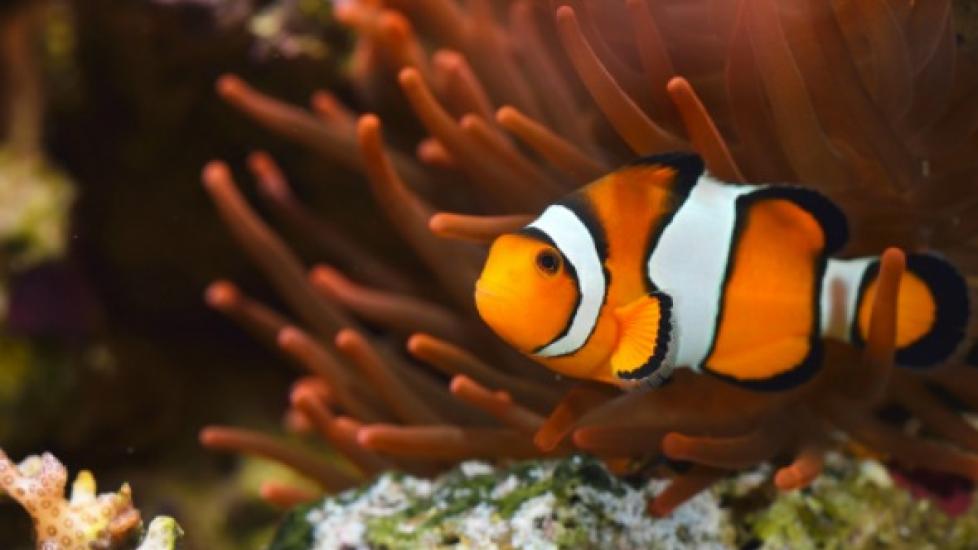6 Facts About Clownfish
By Vanessa Voltolina
Made popular by an infamous fish named Nemo, what you may not know about clownfish is that they are one of the most popular types of fish an aquatic pet parent can own.
Dr. Gregory Lewbart, Professor of Aquatic, Wildlife and Zoologic Medicine at North Carolina State University, spoke with us about some of the lesser-known facts about this interesting species, as well as some care guidelines for prospective owners that can make caring for your clownfish easier.
Fact #1: What’s in a Name?
Clownfish are part of the species of anemonefish, named for the sea anemones in which they make their homes, confirms Lewbart. There are 28 species of these fish, however clownfish are the most commonly kept species, he said.
Fact #2: They’re More Colorful Than You Think
You’ll know a clownfish when you see one: most clownfish are orange, with three white bands (outlined in black) on the head and body and a signature rounded tail. Despite the typical look that many of these fish boast, they also come in colors such as pink, red, yellow, black, brown and multi-colored stripes, Lewbart confirmed. So, for prospective fish owners who like the idea of a diversely-colored tank, this is a possibility with clownfish—just be sure to ask for different colored fish when you are purchasing them. Additionally, purchasing a captive-bred clownfish for your tank is both environmentally responsible and these fish are more adaptable to living in home aquariums.
Fact #3: A Good Fit for First-Time Owners
Unlike a number of fish species who may find themselves being flushed down the toilet all too soon to the chagrin of most owners, clownfish have a relatively long life. They are a hardy, peaceful group of fish that grow to be around three to four inches and are relatively easy in terms of care.
“Clownfish appear to be particularly long-lived, and can probably live up to 30 years, but a lifespan of 10 to 15 [years] seems about average,” he said. This is both a blessing and a curse, depending upon your goals. These fish aren’t for owners looking for a short-term pet, confirms Lewbart, so be sure to plan accordingly.
Fact #4: Clownfish are Omnivores ...
Translation: They eat both meat and plants. The average clownfish diet typically consists of algae, zooplankton, worms and small crustaceans. Ultimately, when feeding any clownfish, variety is the key, said Lewbart. “A mixture of frozen foods, flakes and pellets, and greens should do the trick,” he said. He suggests minimizing or excluding live foods, as they can sometimes carry parasites and other pathogens.
As far as how much you should feed your clownfish, he said that this can sometimes be difficult to estimate, but suggests one method: the rule of five minutes. “See how much a fish can eat in five minutes after adding food to the tank,” he said. “This usually works out to about one-to-three percent of their bodyweight.”
Fact #5: ... And Social Butterflies
Ideally, clownfish are able to cohabitate with many other species—including damsels, gobies, puffers and live corals, you name it—confirms Lewbart (of course, you’ll want to avoid species such as groupers, scorpions, seahorses, sharks and rays, all predatory fish that can eat clownfish). If your goal is to integrate your new clownfish with other species that they get along with, they should be purchased in small groups consisting of one species and introduced to the aquarium simultaneously Lewbart said.
Introducing different species fish, as well as corals, plants, other invertebrates, is one of the riskiest of endeavors when it comes to pet fish keeping, he said. For starters, any new plants or fish will need to be quarantined for at least 30 days before being added to the existing system/aquarium. “I can't tell you how many times newly-introduced animals spread pathogens to established tank residents,” Lewbart said.
While the 30 days isn’t a guarantee, it allows for existing problems—unapparent to the naked eye—to surface in the plants and fish before they can be introduced to the tank.
He suggests a simple as a five-gallon bucket with a box filter or air stone as a habitat for quarantined fish or plants. “After an adequate quarantine, appropriately-selected fish should be acclimated with a mixture of aquarium water and quarantine water for about thirty minutes before adding the fish (but not the water) to the aquarium,” he said. Acclimation can be accomplished most easily by running a drip line from your aquarium that will add one drop of water about every three seconds to the quarantine bucket.
Fact #6: They Require a Super-Clean Home
Anemonefish require a saltwater aquarium of at least 30 gallons, armed with the proper equipment—such as adequate filtration, pumps, water supplements, and live rock and sand. As such, clownfish do require stricter tank maintenance than other species. They require a water temperature between 72 and 78 degrees Fahrenheit, and a pH of 8.1-8.4 (as more basic pH ranges are often indicated for saltwater aquariums). Additionally, Lewbart recommends a 25 to 30 percent tank water change monthly.
While these fish are relatively easygoing, the bulk of the heavy lifting for new clownfish owners is often maintaining a proper environment. Decide if you have the time properly maintain your clownfish’s environment before purchasing one.
